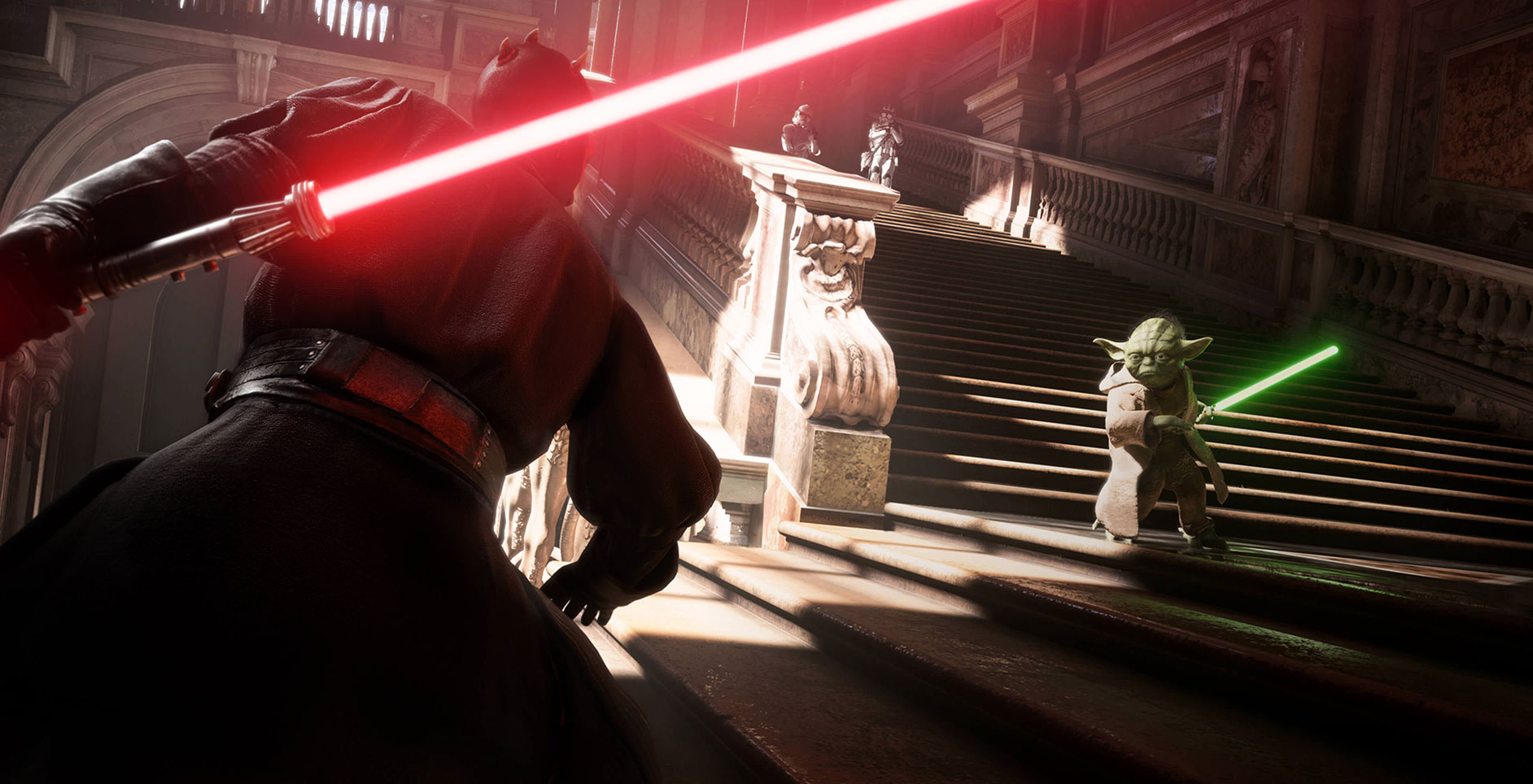EDITOR’S NOTE: This review contains words by James (Single Player) and Toby (Multiplayer). Toby flew to San Francisco for the multiplayer review event as a guest of EA.
SINGLE PLAYER CAMPAIGN
Star Wars Battlefront II’s campaign takes place between Return of the Jedi and presumably ends at some point between The Force Awakens and The Last Jedi. Such a period seems rife for some interesting stories to be told given how long it is and where the characters end up between then and now. Rather than solely focus on the characters we know and love, Battlefront II introduces us to Iden Versio. She’s an esteemed commander for the empire, giving players an insight into the other side of the war we never really get to see.
Or at least that’s what the writers thought we’d see. Instead, unfortunately, Battlefront II falls into the rather disappointing trap of portraying both sides of the war as black and white; with very little grey. Iden begins the campaign as a ruthless leader but within the first few chapters falls victim to cheap stereotypes. Those looking for some interesting insight into what it would be like to live and breathe the Empire’s dogma will be sorely disappointed. This is typical Star Wars fare.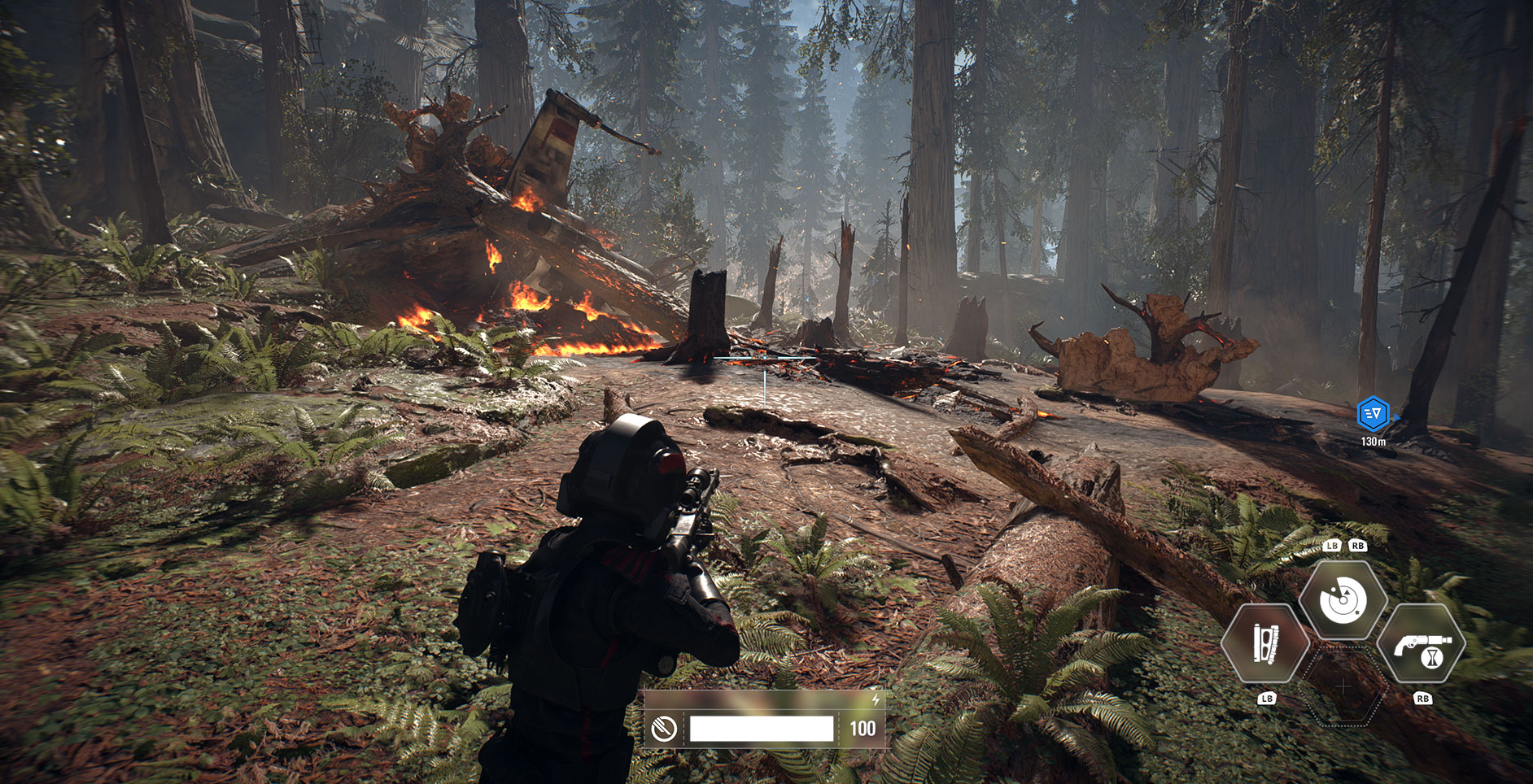 Iden herself is a likeable character if not slightly generic. When you’re playing as her, you’ll be controlling both her and her support droid through a combination of sneaking, shooting and piloting various spacecraft. Unsurprisingly, Iden’s segments are probably the least interesting of the campaign, especially in the first half. The drone provides a cool way to take care of enemies you’re not directly aiming at, but otherwise you’ll just be clearing areas of enemies, moving to a waypoint and repeating ad nauseum.
Iden herself is a likeable character if not slightly generic. When you’re playing as her, you’ll be controlling both her and her support droid through a combination of sneaking, shooting and piloting various spacecraft. Unsurprisingly, Iden’s segments are probably the least interesting of the campaign, especially in the first half. The drone provides a cool way to take care of enemies you’re not directly aiming at, but otherwise you’ll just be clearing areas of enemies, moving to a waypoint and repeating ad nauseum.
The campaign feels flat and for a while I couldn’t work out why, but then it became obvious. Between missions, all the cooler and more epic moments happen in pre-rendered cinematics which really take you out of the moment. Games like Call of Duty and Uncharted aren’t afraid to let grandiose moments happen in real-time through the eyes of the player character. These moments add tension. In Battlefront II, I never felt that tension because I knew Iden couldn’t die in a cinematic.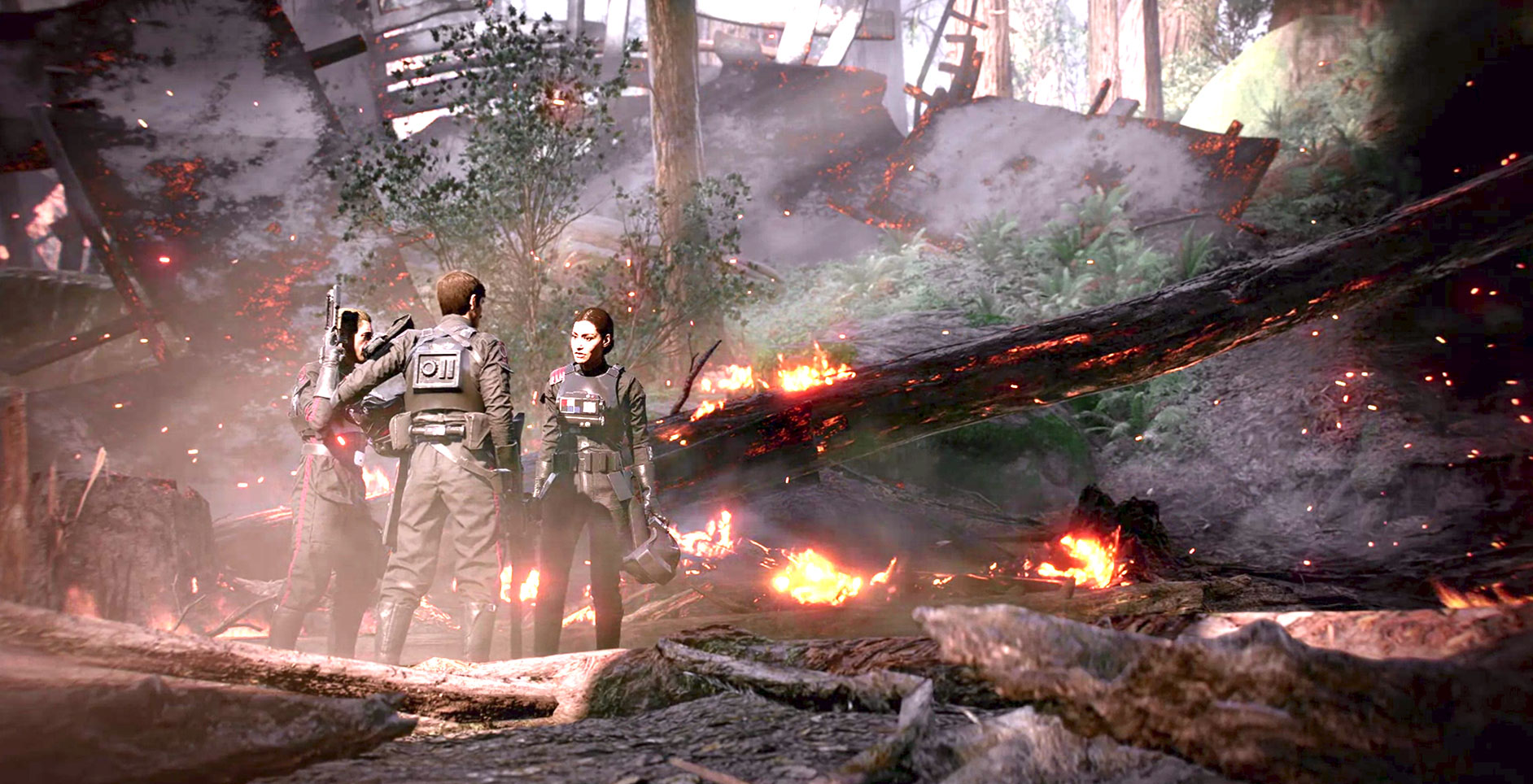 Things pick up a little bit towards the end for Iden, where the setpieces, while flat, have a greater sense of scale. Other times, you’ll be randomly thrown into the shoes of some more recognisable characters. Luke, Leia, Lando, Han and Kylo Ren are all playable in the campaign at some point and the quality of their levels are equally as dubious as Iden’s. Luke’s level is easily the weakest, a majority of which is spent defending a member of Iden’s squad from violent bugs. It has relevance to the overall story (as Kylo Ren will discover in the final chapter) but just feels like a missed opportunity.
Things pick up a little bit towards the end for Iden, where the setpieces, while flat, have a greater sense of scale. Other times, you’ll be randomly thrown into the shoes of some more recognisable characters. Luke, Leia, Lando, Han and Kylo Ren are all playable in the campaign at some point and the quality of their levels are equally as dubious as Iden’s. Luke’s level is easily the weakest, a majority of which is spent defending a member of Iden’s squad from violent bugs. It has relevance to the overall story (as Kylo Ren will discover in the final chapter) but just feels like a missed opportunity.
The problem with these hero moments are that not only do they fall flat but also that they provide little context to where these characters were at right before you take control of them. This is presumably due to the age-old problem of the Star Wars creatives wanting to leave as much space open as possible in the timeline to explore stories with greater depth later.
Die-hard Star Wars fans take heed; there is little story, plot, context or consequences that is important to the overarching mythos of the universe here. All you’ll discover about the characters during the time between Return of the Jedi and The Force Awakens is that they visited all these locations at some point and did some stuff at said locations. Leia visited Theed. Lando visited Sullust. Han has been to Maz’s bar more than once. Luke killed bugs and took a compass from a planet called Pillio.
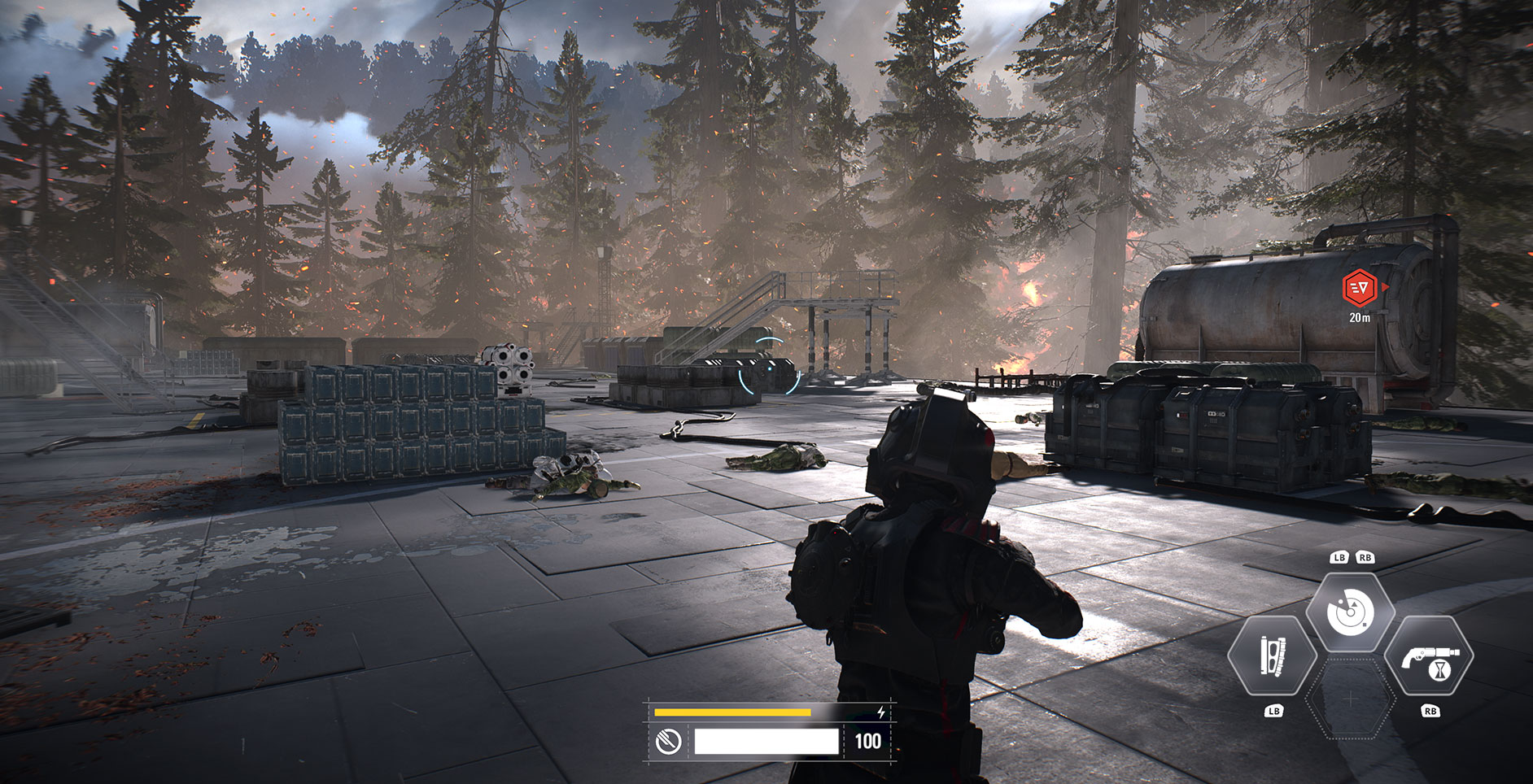
It would be remiss of me to not mention that this plot revelation for Luke is mentioned in expanded universe materials, but it’s clearly meant to be revisited later. In fact, the most disappointing thing about Battlefront II’s campaign is that most characters (including Iden) don’t get much closure to the events. This is probably because the game will be expanded with extra content as time goes on, as several plot threads are left hanging, but it’s still disappointing that the campaign feels so undercooked.
Ultimately, at the end of the day, I’d be lying if I didn’t say that I enjoyed playing through the six hour Star Wars Battlefront II campaign. Most of that was me excited to see what it would be like to play a high-ranking Imperial officer or to see what happened to my favourite characters between the films. Unfortunately, the campaign for Battlefront II fails to deliver on either of these fronts. There’s a campaign here and it ticks all the boxes of what constitutes a campaign, but most gamers have played better. Many referred to the campaign as an “untold soldier’s story”. After experiencing that story, I can’t help but feel it should have stayed that way.
MULTIPLAYER
Star Wars Battlefront II is everything the first game should have been. Comprised of a range of enjoyable multiplayer modes, alongside a fun arcade mode that throws you into iconic battle scenarios from both sides of the force, Battlefront II feels more fleshed out than the first ever did. That said, there are some noticeable issues that hold the game’s multiplayer experience back from being as fantastic as it probably should be.
The biggest addition to this year’s Battlefront outing is something fans have been clamouring for since the first game hit shelves: Starfighter Assault.
Starfighter Assault pits two teams of twelve against one another above some of the universe’s most iconic planets. Taking control of a range of recognisable Star Wars fighter ships, one team is tasked with multistaged attacking objectives, whereas the defending team has to try and hold them off until the attacking team’s respawn tickets are depleted. Attacking objectives range from destroying a ship’s couplings (and then taking out its reactor), to destroying shield projectors, in turn making for some of the game’s best moments by far.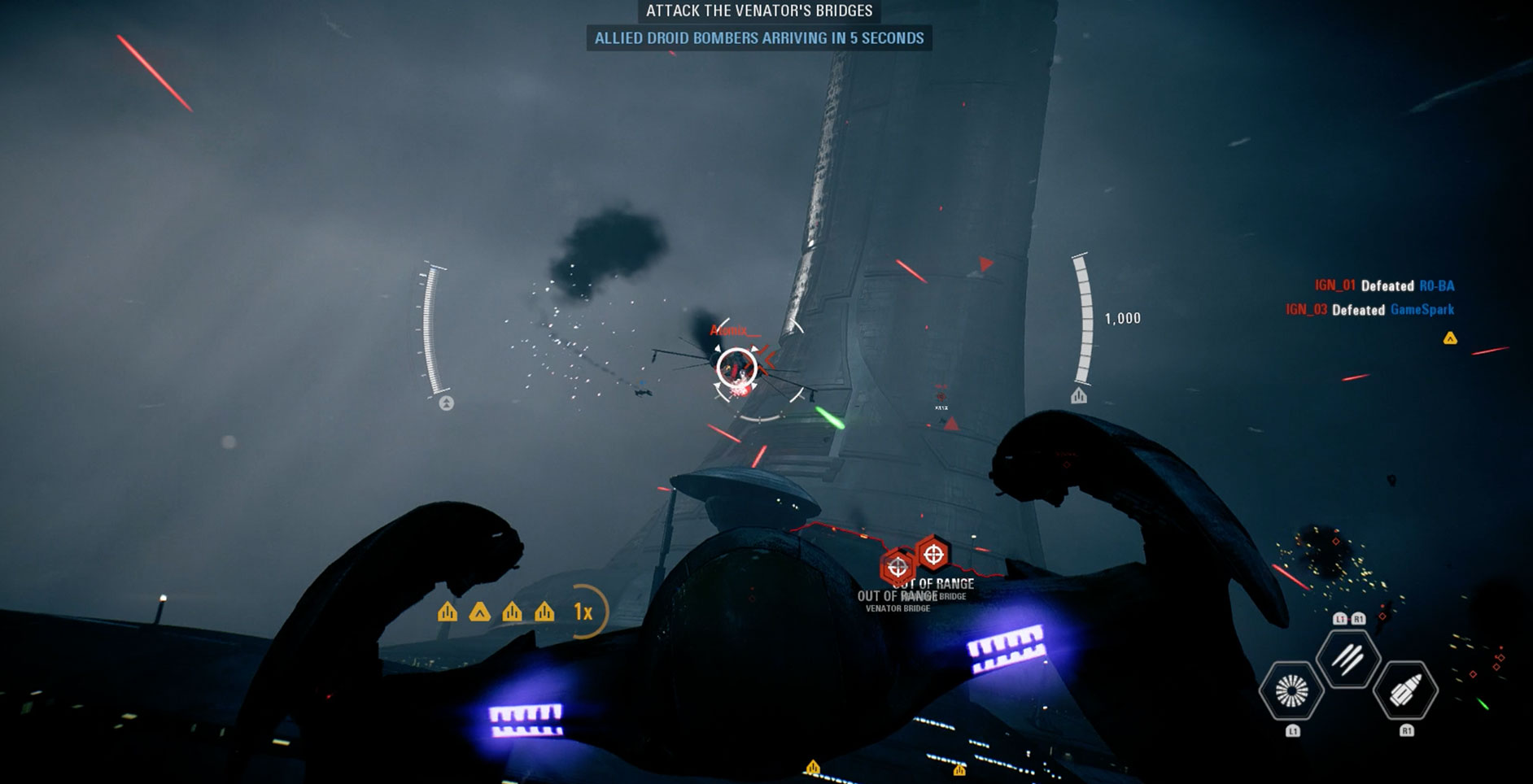 There are three main ships that can be used in this mode, from the all-purpose fighter, the heavy-focussed, slow moving bomber, to the fast-moving, agile interceptor — each ship serves its own purpose in a dogfight, though I found the interceptor to be the most useful throughout. The reason for this is because agility in space is necessary when trying to avoid enemy fire, and an interceptor’s quick reaction speed and ability to scoot away from a bad situation bailed me out more times than I’d like to admit. The aforementioned bigger ships — the fighter and the bomber — had no way of catching up to me for the most part, in turn allowing me to continue on with my objectives or shooting down enemy ships.
There are three main ships that can be used in this mode, from the all-purpose fighter, the heavy-focussed, slow moving bomber, to the fast-moving, agile interceptor — each ship serves its own purpose in a dogfight, though I found the interceptor to be the most useful throughout. The reason for this is because agility in space is necessary when trying to avoid enemy fire, and an interceptor’s quick reaction speed and ability to scoot away from a bad situation bailed me out more times than I’d like to admit. The aforementioned bigger ships — the fighter and the bomber — had no way of catching up to me for the most part, in turn allowing me to continue on with my objectives or shooting down enemy ships.
Like ground infantry, ships also have three ability slots, and making use of them can be the difference between life and death in Starfighter Assault. The reason I used the interceptor so much was because the ship had an ‘afterburner’ ability, giving me a huge speed boost for a limited period of time — perfect for getting away from enemy fire. And it was through the use of these abilities, which vary greatly depending on the ship you’re piloting, that made dogfights in space some of the most intense moments Battlefront II manages to offer. The sense of scale here, if anything, is unparalleled elsewhere in the multiplayer space, and having iconic John Williams music playing in the background added to the experience tenfold — it was brilliant.
Alongside the core ships, as you play through Straighter Assault you’ll also eventually gain the ability to spawn in as a hero ship. These range, of course, depending on the side you’re on and how many points you have, with some of the more powerful ships (like Darth Maul’s Scimitar and Yoda’s Jedi Starfighter) costing upwards of 6,000 battle points to spawn in. Battle points are accumulated via playing the objective, taking out enemy ships, and assisting teammates, and are present throughout the entirety of the Battlefront II multiplayer experience.
 Taking things to the ground, and Battlefront II offers up a swath of modes to sink your teeth into. One of these is Strike, an 8 v 8, objective-based mode that dials back the scope seen in other modes with a focus on close quarters combat and reactionary play. It doesn’t necessarily feel as grand as Starfighter Assault or some of the other modes included, but it’s serviceable and offers up a good amount of fun when breaking from Battlefront II’s bigger, more hefty multiplayer battles. It’s also worth mentioning that heroes are disabled in Strike, meaning special units are few and far between and don’t influence the tide of battle all that much. You still have access to special droid units, for instance, which have unique abilities like rocket boosters and more powerful attacks, but their health is limited and they don’t make quite the effect a hero character does.
Taking things to the ground, and Battlefront II offers up a swath of modes to sink your teeth into. One of these is Strike, an 8 v 8, objective-based mode that dials back the scope seen in other modes with a focus on close quarters combat and reactionary play. It doesn’t necessarily feel as grand as Starfighter Assault or some of the other modes included, but it’s serviceable and offers up a good amount of fun when breaking from Battlefront II’s bigger, more hefty multiplayer battles. It’s also worth mentioning that heroes are disabled in Strike, meaning special units are few and far between and don’t influence the tide of battle all that much. You still have access to special droid units, for instance, which have unique abilities like rocket boosters and more powerful attacks, but their health is limited and they don’t make quite the effect a hero character does.
A mode I didn’t particularly like was Blast, which is Battlefront II’s team death-match mode. Unlike Strike, Blast’s 10 v 10 combat is all about depleting the other team’s respawn tickets, though the maps included feel way too big for the player count. In particular, my time with the mode on Mos Eisley consisted of me running around for far too long before getting into any combat, and even then I’d just be pinged off by a rogue shot in the distance.
Further, in Blast more than any other mode I was consistently spawned behind random, small objects that would block me from moving forward. These objects were small decorations placed around the game’s maps, and every second or third spawn I’d encounter them blocking a straight run forward into battle. It was bizarre, and by the time I finished up with the mode I was really frustrated with why it was happening.
The final couple of modes are two of Battlefront’s best: Galactic Assault and Heroes vs Villains. Galactic Assault is the pinnacle of everything DICE and Criterion want to showcase in Battlefront II: huge 20 v 20, objective-based battles across sprawling Star Wars landscapes. These symmetrical battles embrace the scale and scope seen in the beloved universe, and places like Jakku, Yavin, and Tatooine truly feel lived in. I was countlessly left in awe as I saw AT-AT’s make a march towards the Imperials in Hoth and the Resistance hold up against the First Order in Jakku, and it was in these moments that I felt more immersed than ever in Battlefront II. Galactic Assault is, by all means, a demonstration of all that is good about Battlefront II, and is the culmination of all of the little systems the dev teams have implemented coming together to form as one.
Galactic Assault is the pinnacle of everything DICE and Criterion want to showcase in Battlefront II: huge 20 v 20, objective-based battles across sprawling Star Wars landscapes. These symmetrical battles embrace the scale and scope seen in the beloved universe, and places like Jakku, Yavin, and Tatooine truly feel lived in. I was countlessly left in awe as I saw AT-AT’s make a march towards the Imperials in Hoth and the Resistance hold up against the First Order in Jakku, and it was in these moments that I felt more immersed than ever in Battlefront II. Galactic Assault is, by all means, a demonstration of all that is good about Battlefront II, and is the culmination of all of the little systems the dev teams have implemented coming together to form as one.
At its best, this is exactly what I want out of a Star Wars game. That’s due to the fact EA have brought all three trilogies into the fray this time around, opening up a gargantuan well of content for fans to enjoy.
This is just as prominent in the returning Heroes vs Villains, a 4 v 4 mode that has players choose iconic heroes from the series and pit them against one another in a light side versus dark side battle. Each team has 10 respawn tickets, and each round a target is picked on either side. The goal here is to eliminate the target on the other team while defending your own, and it’s great fun.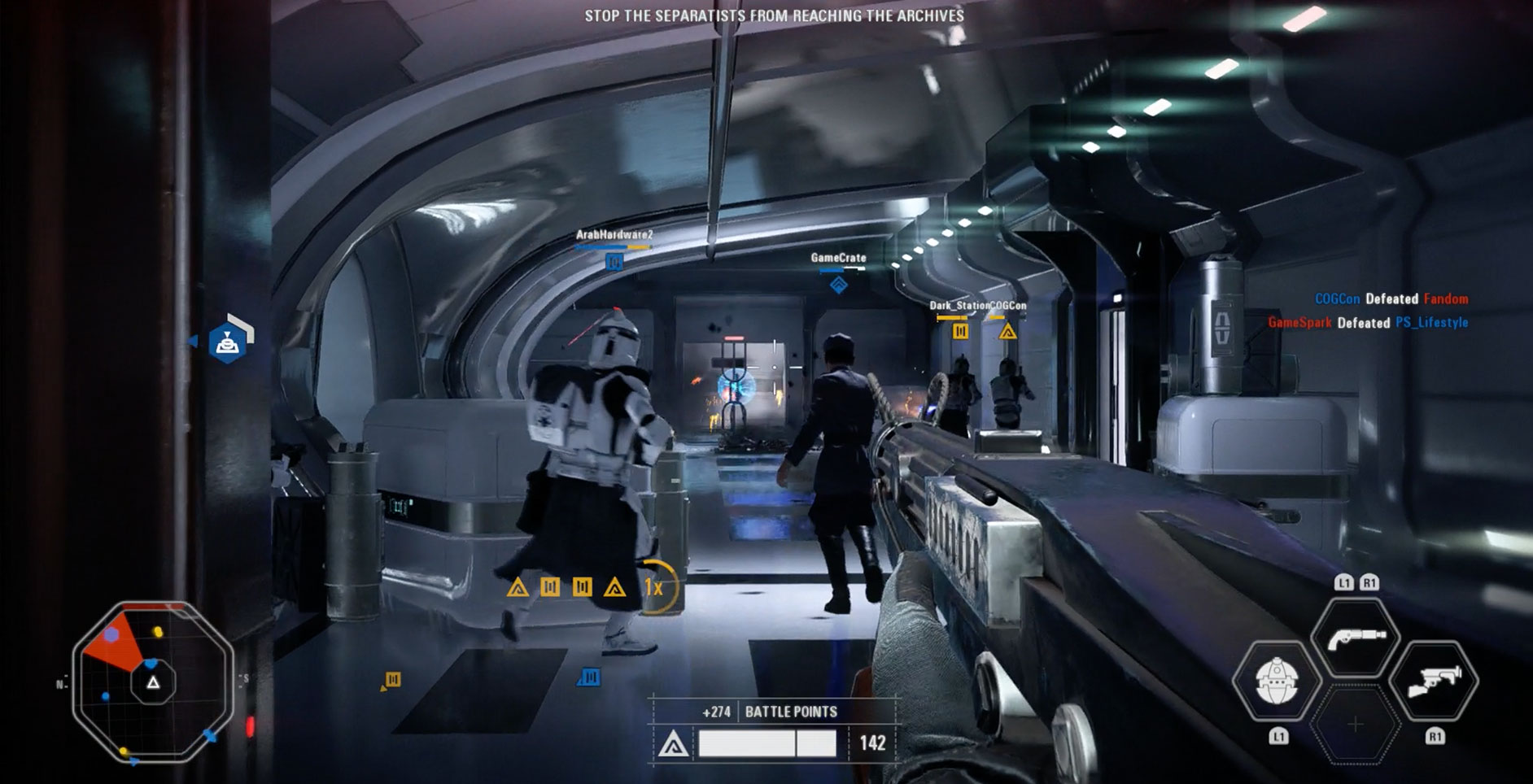 The inclusion of heroes like Darth Maul, Kylo Ren and Rey makes Heroes vs Villains feel more diverse than ever before, and culminates in some dream team-style match ups. I found ranged characters did a lot more damage than Jedi in this mode, and more often than not I’d be able to sit back and take out Jedi before they even got to me if I was Leia or Boba Fett, which was odd.
The inclusion of heroes like Darth Maul, Kylo Ren and Rey makes Heroes vs Villains feel more diverse than ever before, and culminates in some dream team-style match ups. I found ranged characters did a lot more damage than Jedi in this mode, and more often than not I’d be able to sit back and take out Jedi before they even got to me if I was Leia or Boba Fett, which was odd.
Each of the five Battlefront II multiplayer modes are fun in their own way, but while the sense of scope, scale, and the orchestra backing your every move comes together to form a fun Star Wars experience, the game does make silly choices that hamper the multiplayer in significant ways. The biggest of these is the lack of in-game voice chat.
For a game that is all about objectives, a lack of voice chat really makes no sense. At times I’d find my team veering off in the wrong direction, and there was no way for me to indicate to them that we’d need more people on another objective or defending an area. More baffling is the fact you are grouped in a squad and are awarded extra points by sticking with them — but when you can’t chat there’s no way to even really distinguish where they are or have ventured off to. It’s stupidly frustrating.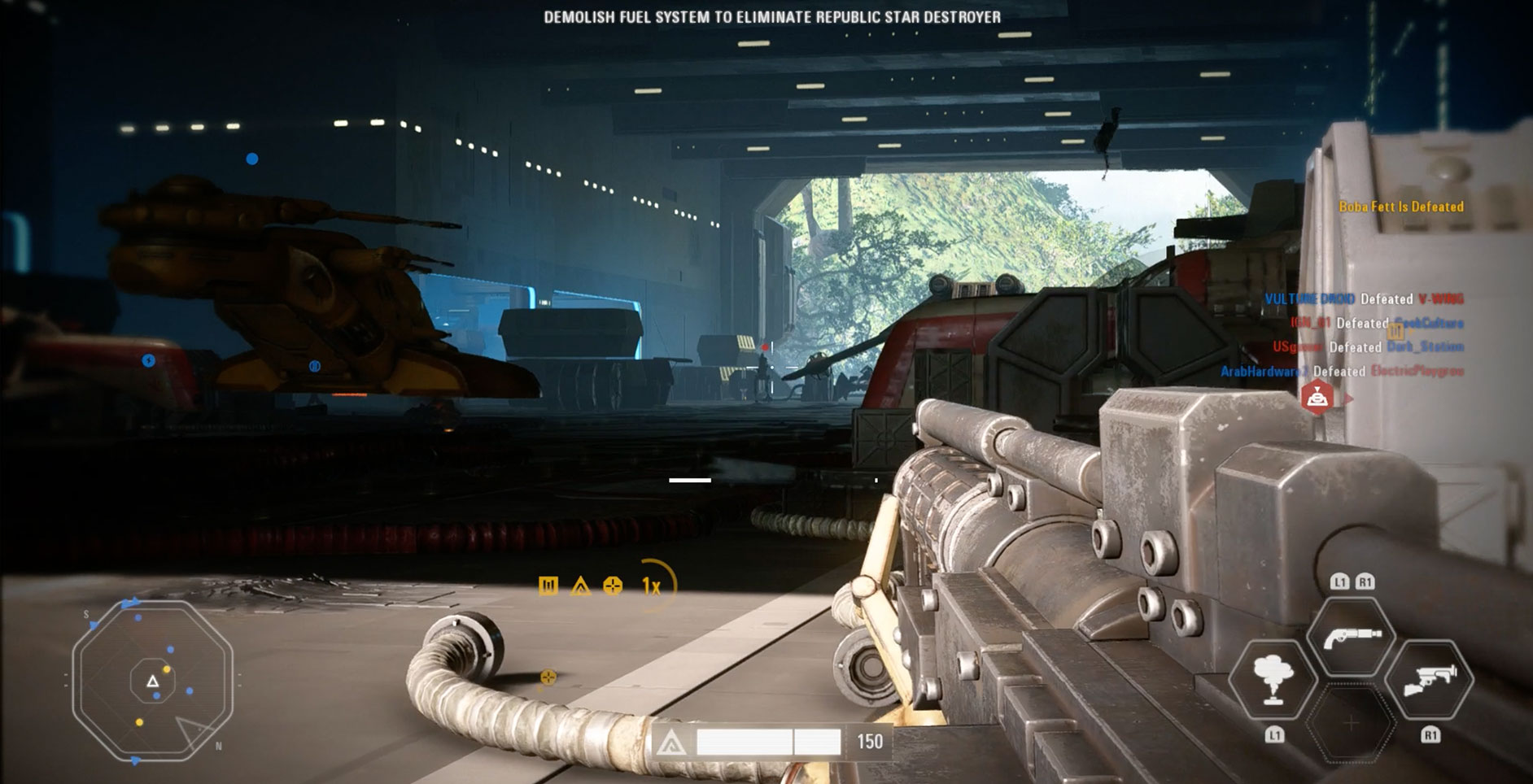 Further, there’s no server browser included in this year’s Battlefront II, and the auto balancing of teams doesn’t seem to be working all that well. I was consistently matched up against most of the higher ranked players during the review event, and often noticed a team would have an extra two players when a match commenced. It’s little things like these that really detracted from the overall experience.
Further, there’s no server browser included in this year’s Battlefront II, and the auto balancing of teams doesn’t seem to be working all that well. I was consistently matched up against most of the higher ranked players during the review event, and often noticed a team would have an extra two players when a match commenced. It’s little things like these that really detracted from the overall experience.
Let’s also address the elephant in the room: Star Cards. Star Cards still affect the way you play in Battlefront II, and though the unlocking of the highest tier of Star Cards has changed to in-game progression, you can still buy cards in loot crates that give you a massive advantage in battle. I managed to equip myself with some pretty beefy cards early on in the event, and they had a huge impact on the way matches played out and how 1v1’s went down. You can grind for cards, of course, but expect to play five to ten matches a pop to gain access to another worthwhile crate.
There are three currencies in Battlefront II: one you can purchase (crystals), an in-game currency (credits), and crafting parts. The latter allows you to upgrade your Star Cards, but you also have to complete milestones with that card in order to unlock the higher tier.
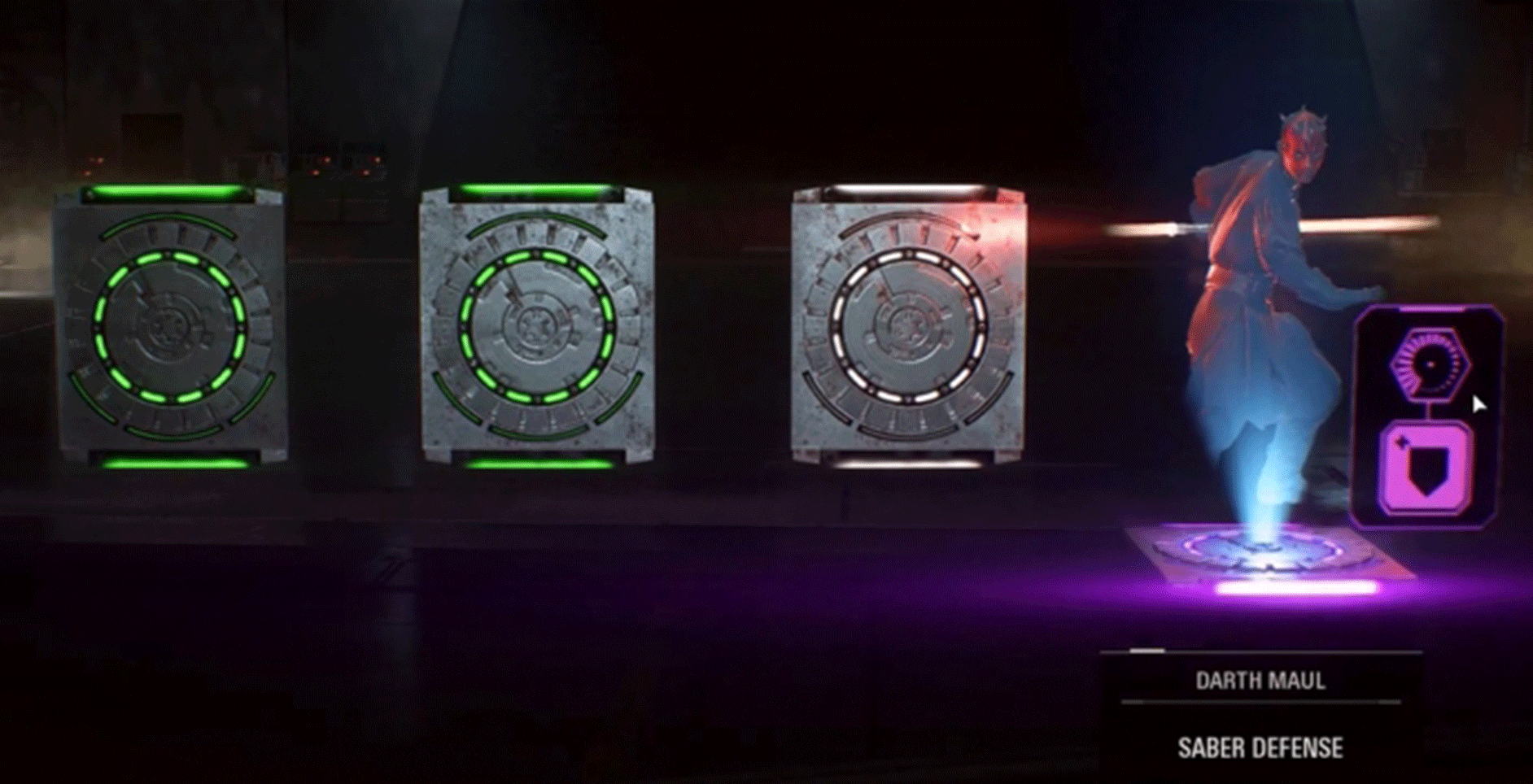
Milestones are Battlefront II’s challenges, and there are a lot of them. They cover all facets of the Battlefront II experience, from the game’s single-player campaign, to multiplayer, to arcade mode — everything you do in Battlefront II will be worth something through milestones. Some, for example, task you with getting 50 kills with an assault weapon, whereas another is to defeat 500 enemies in multiplayer. Every time you complete a milestone you’ll be awarded with something, whether that’s a loot crate, some in-game currency, or crafting parts — everything contributes towards player progression. You’re also able to change player emotes, victory poses, and equip star cards in this area in the menu, too, as well as being able to purchase some of the locked heroes through in-game currency.
Whilst the balance might be off, and tweaking might be needed required post launch, having this included in Battlefront II makes the experience better. To have something to work towards means you’re constantly rewarded with some sort of progression in the game, and coming back and checking in on how you’re going makes the game’s grind all that much more enjoyable.
If you want to get to grips with the game and its gameplay systems, Battlefront II’s arcade mode is the perfect way to do it. With 16 seperate battle scenarios (8 light side, 8 dark side) stretched across the series’ three trilogies, arcade mode allows you to refine your tactics and prepare for what’s to come in the game’s multiplayer.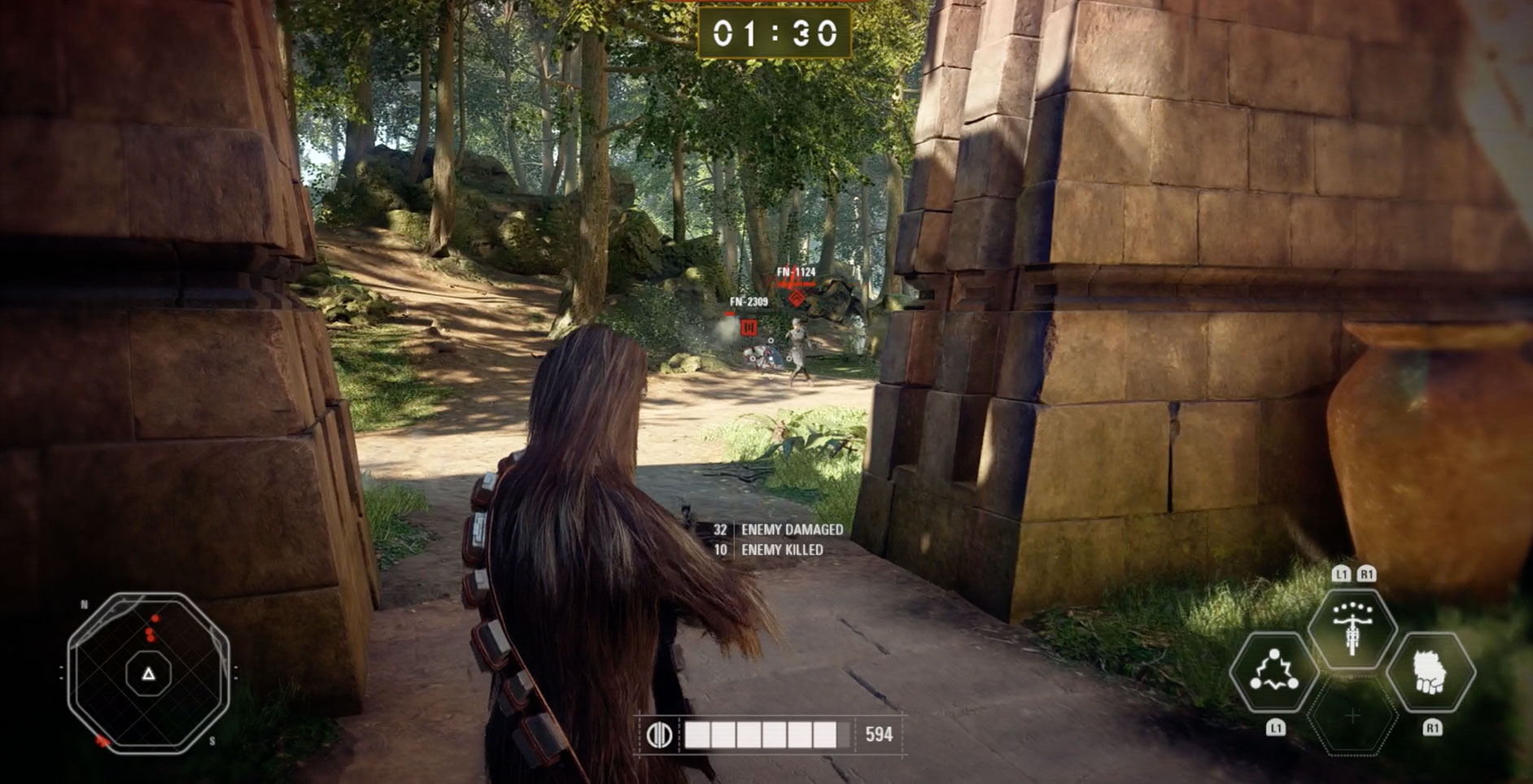 Each battle scenario is different in arcade mode, though most give you either a time limit or a score to hit to complete it. Some also include modifiers, like a mini map that indicates where all of the enemies are, for example, and changes to time or score requirements. When you finish a scenario, a harder version of it will unlock, opening up a tougher challenge to venture through with changed conditions. With three tiers set for each of the 16 scenarios, accuracy and knowledge become key components in completing all three difficulty tiers.
Each battle scenario is different in arcade mode, though most give you either a time limit or a score to hit to complete it. Some also include modifiers, like a mini map that indicates where all of the enemies are, for example, and changes to time or score requirements. When you finish a scenario, a harder version of it will unlock, opening up a tougher challenge to venture through with changed conditions. With three tiers set for each of the 16 scenarios, accuracy and knowledge become key components in completing all three difficulty tiers.
Arcade mode is also the perfect place to get used to the game’s heroes and how they work, and this can also be done through the use of the custom arcade mode, which allows you to modify game rules for different types of training, or via the mode’s tutorial. You can also play split screen in arcade and battle it out against a friend, rounding out what is an impressively beefy addition to the Battlefront experience.
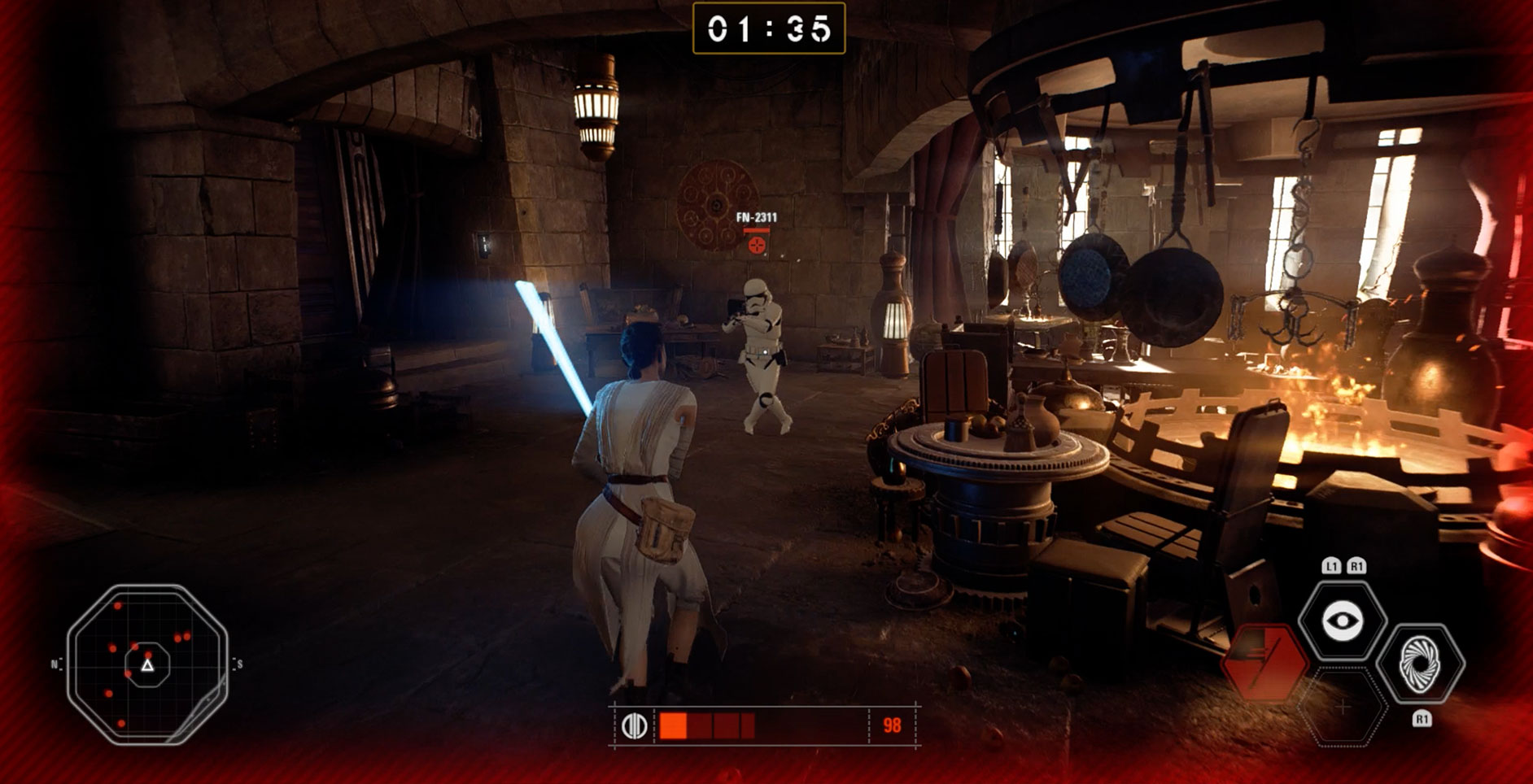 As a package, what’s on offer in Star Wars Battlefront II is impressive. It’s a huge step forward for the series, and rightly corrects the wrongs seen in the first game. That said, it is still marred by some bizarre choices that affect the multiplayer experience in annoying ways, like the lack of in-game voice chat. The Star Card system remains an issue as well, and I’m worried that the changes EA have made have not been enough to make grinding for cards a viable option, especially when others who buy a bunch of crates will have a noticeable advantage on the battlefield.
As a package, what’s on offer in Star Wars Battlefront II is impressive. It’s a huge step forward for the series, and rightly corrects the wrongs seen in the first game. That said, it is still marred by some bizarre choices that affect the multiplayer experience in annoying ways, like the lack of in-game voice chat. The Star Card system remains an issue as well, and I’m worried that the changes EA have made have not been enough to make grinding for cards a viable option, especially when others who buy a bunch of crates will have a noticeable advantage on the battlefield.
From a pure gameplay standpoint, though, Battlefront II is the most immersive Star Wars experience I’ve had in a long time, and with the promise of seasonal free content drops coming for quite some time in the future, it should at the very least be something fans can enjoy and grow with. Its gameplay is fantastic and sound design brilliant, only brought down by choices that can hopefully be refined and redone overtime.


